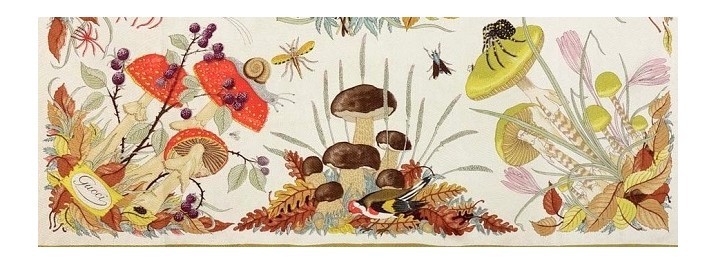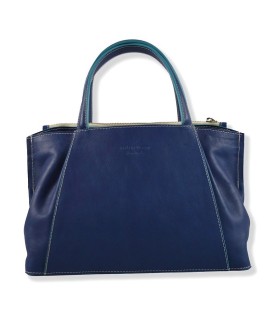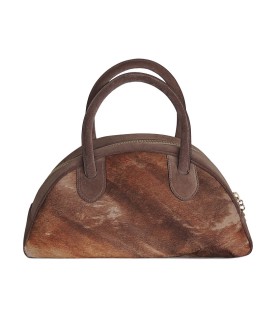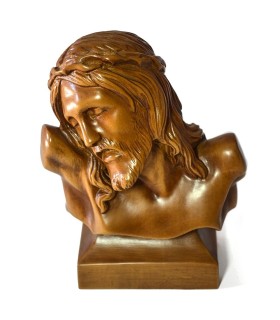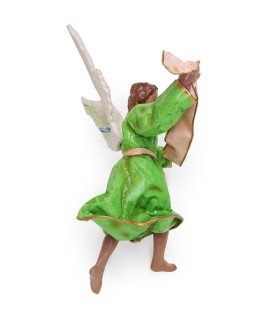“Silk Gardens - Vittorio Accornero for Gucci” The Exhibition
The historic Gucci scarves in a splendid exhibition

The exhibition "Silk Gardens - Vittorio Accornero for Gucci" is a project of the Agave publishing house in Sassari and avails itself of the collaboration of the Gucci Museum in Florence. Already held in Sassari and Alessandria, the exhibition represented Italy at the Beijing Book Fair in 2012.
The subject of the exhibition and the catalog is the work carried out for the Maison Gucci by the Piedmontese artist Vittorio Accornero, during the sixties and seventies of the last century. A collection of about seventy scarves, including the famous Flora, one of the Maison's trade marks.
It is an exhibition and a catalog of great freshness and enjoyment, representative of a historical period among the most relevant for Italian design and fashion, among the points of reference for the affirmation in the collective imagination of a winning idea. of Italian style.
The scarves of the stars
The scarves designed for Gucci by Vittorio Accornero were an indispensable part of the wardrobe of elegant women in the sixties and seventies. Worn by such diverse female icons as Grace Kelly, Jacqueline Onassis, Sofia Loren and Monica Vitti, these exquisite frivolities are today coveted and sought-after objects by collectors, but not only: they also represent a chapter in themselves in the history of this fashion accessory.
The exhibition presents for the first time a rich selection of the approximately 80 scarves made by the artist over the course of twenty years of collaboration with the Florentine company, from 1960 to 1981.
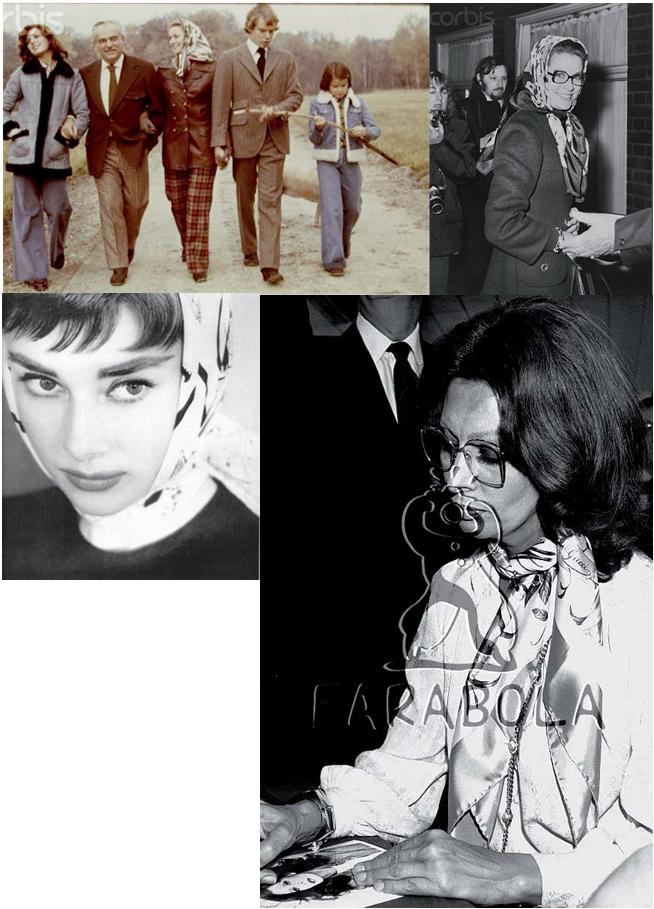
Vittorio Accornero and Gucci Vittorio Accornero de Testa is one of the leading names in twentieth-century Italian illustration. He was called to collaborate with Gucci in 1960 by Rodolfo Gucci, son of the company's founder. The first series of scarves he created focus on themes related to travel and horse riding (Gucci was born in 1922 as a leather goods company, a manufacturer of luggage and saddlery items) such as trains, trams, stagecoaches, carriages, and other subjects such as firefighters and bottles with sailing ships. A turning point was, in 1966, the famous Flora scarf created for Grace Kelly. Legend has it that Rodolfo Gucci asked the Princess of Monaco, visiting the Milanese store of the company, what she wanted as a gift, being asked for a brightly colored floral scarf. But in the whole Gucci production a model with such a fantasy was missing: Rodolfo then ran to Accornero who designed one in just one night. Thus was born Flora, inspired by the female figure of the same name in Botticelli's Primavera: an amazing shower of bouquets of flowers of all seasons, meticulously described, in a kaleidoscope of dazzling colors.
Flora was destined to become a cult of fashion, an object of desire for generations of women; the design of him would have been taken years later by Gucci (by now passed under the control of the Pinault group), and still today it is found applied to bags, shoes, jewelry and clothes. But above all, the mythical design created for Grace Kelly was to mark a turning point in the production of scarves. Throughout the sixties and seventies, Gucci scarves represented the discreet charm of the "classic of clothing" and, thanks to Accornero's work that introduces the concept of seasonality in decorative motifs, fully entered the fashion circuit.

Disegnato per Grace Kelly, è il modello che segna una svolta nella produzione di Gucci. La leggenda narra che Rodolfo Gucci avesse domandato alla principessa di Monaco, in visita al suo negozio milanese, cosa volesse in dono, sentendosi chiedere un foulard floreale a colori vivaci. Poiché nello stock Gucci mancava una fantasia del genere, Rodolfo si rivolse ad Accornero che ne disegnò uno in una sola notte. Il soggetto – una strepitosa pioggia di bouquet di fiori di tutte le stagioni, minuziosamente descritti, in un caleidoscopio di smaglianti colori – ispirato all’omonima figura femminile nella Primavera di Botticelli, è un omaggio a Firenze e alle origini fiorentine dell’azienda. La novità del tema floreale, diverso dal solito repertorio viaggi-caccia-sport legato all’identità della ditta, l’inedita composizione unitaria invece che formata dalla ripetizione di sezioni speculari, l’accresciuta gamma dei colori, ne fanno una pietra miliare nella storia di questo accessorio di moda. Il motivo di Flora è stato ripreso recentemente da Frida Giannini, designer della Gucci, ed è tuttora applicato a varie categorie di oggetti.

Another key model in the history of the company, this time with an autumn subject and with splendid shades of yellow, ocher and brown. The seasonalization of the motifs, introduced with Flora and the adoption of floral themes, would become a constant in Gucci production.
Vittorio Accornero
Vittorio Accornero de Testa (Casale Monferrato, 1896 - Milan, 1982) is one of the protagonists of Italian illustration from the twenties to the fifties, collaborator (initially under the pseudonym of Max Ninon) of prestigious magazines such as L'Illustrazione Italiana, La Lettura, Grazia, Il Secolo XX and author of the tables of about 60 volumes published by Mondadori, Mursia, Hoepli and other important publishing houses. Between the twenties and thirties he often collaborated with his wife, the illustrator Edina Altara, signing "Edina and Ninon". In the mid-thirties, after entering the world of cinema, as a set designer and costume designer for Guido Brignone and Augusto Genina's films, he began to work for La Scala: his scenes and costumes for the performances staged in that period by the Milanese theater of Marcello by Giordano, Nina pazza d'amore by Paisiello, I cantori di Nurimberga by Wagner, La Bohème by Puccini, etc. In the fifties he devoted himself to painting, with a style of exasperated naturalism reminiscent of the ways of Sciltian.
The relationship with Gucci continued until the threshold of the artist's death; in recognition of his creative contribution, destined to irrevocably mark the look of the company, in 1981 Gucci named him "Gucci Knight of Labor", dedicating him a cup celebrating his long collaboration.




The Silk Gardens
The historic Gucci scarves in a splendid exhibition
The exhibition presents for the first time 40 original scarves of the time, in frames of 100 × 100 cm dimensions accompanied by 10 explanatory panels, for a linear development of about 80 meters of exhibition path. The exhibition can be completed with an introductory part dedicated to Vittorio Accornero in which it is possible to exhibit original illustrations, photographs, prints and objects owned by the artist.
In support of the exhibition it is possible to create an exhibition of on-board menus from the 1920s and 1930s, created by the artist for the most prestigious ocean liners and cruise ships of the time. The Silk Gardens catalog - Vittorio Accornero for Gucci (1960 - 1981). It is a small work, to which Agave Edizioni has given care and attention, especially because the work of Vittorio Accornero, which for the first time was exhibited as a unique creative, really deserves to be valued. It is regularly sold at the Gucci Museum in Florence in the Italian and English versions and the Chinese edition is in progress.

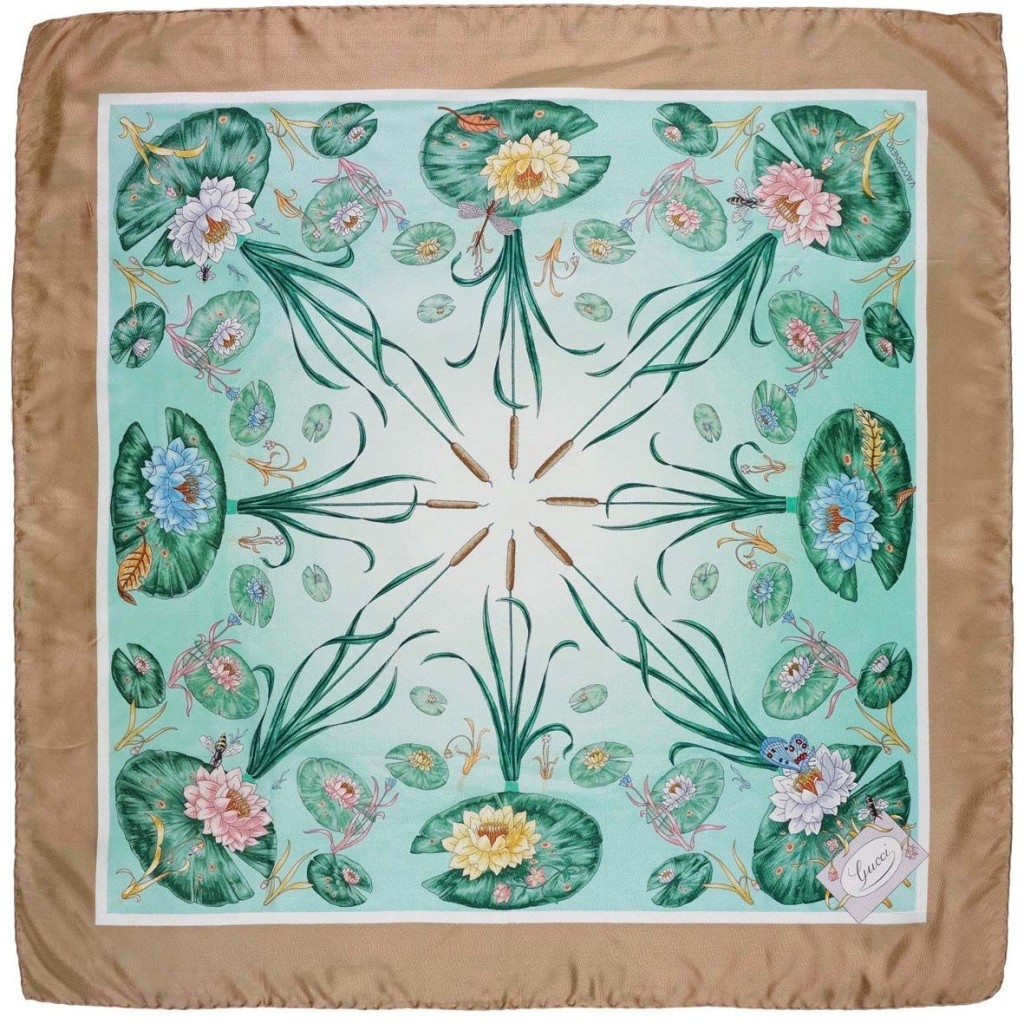
Relatively simple in design, however, it is of great effect due to the mother-of-pearl brightness of the color. The subject of aquatic plants can be found in several tables by Accornero, illustrator of children's books.
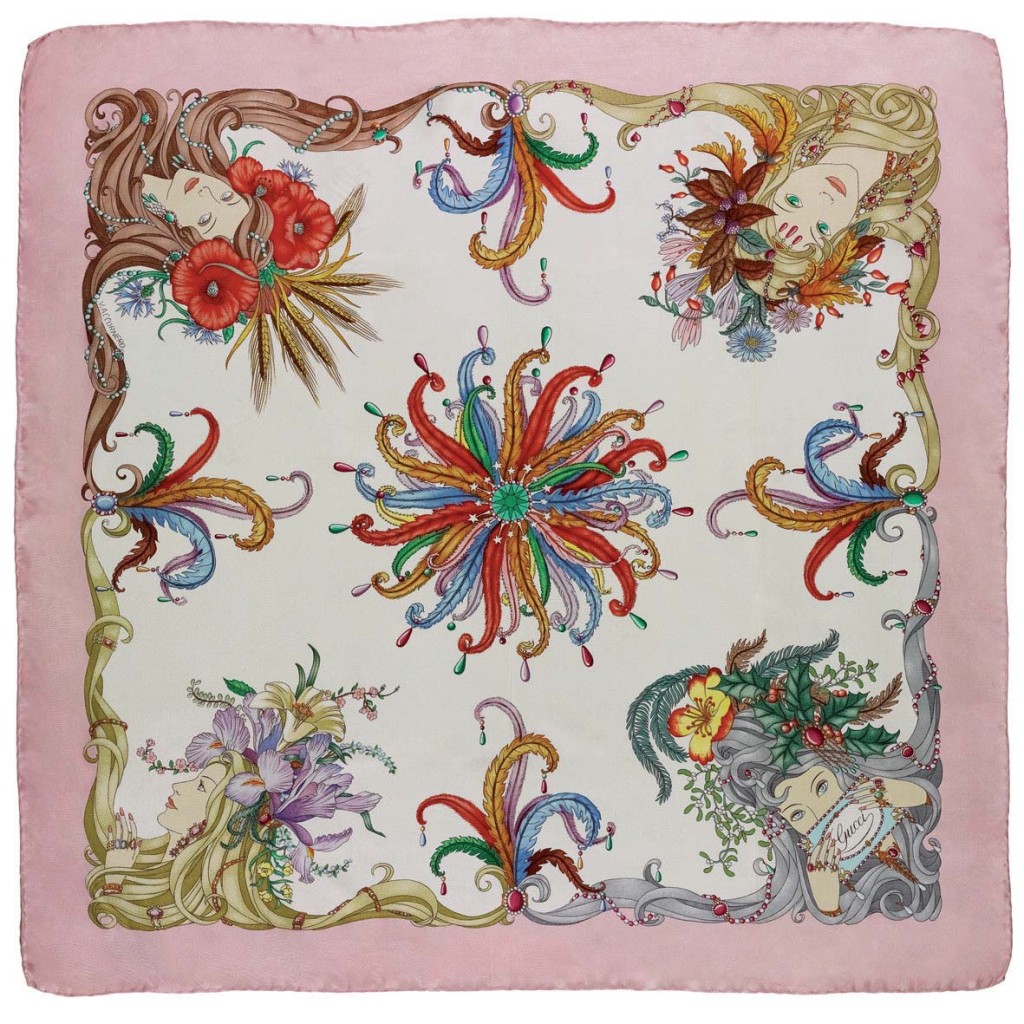
Extravagant hairstyles of feathers and gems serve to distinguish the personifications of the Seasons in this particularly feminine and charming model. Note the detail of the long hairstyles forming the frame, and the card with the Gucci brand held in hand since Winter. In Accornero's notes, a foulard entitled The Four Seasons refers to 1976, but it must be another design; in this case the style suggests an earlier dating.




